General data Area: 44 hectares (the smallest sovereign state of the world)
It is also the only state recognized as non-member of the UNO (observer's statute)
Population: about 1,000 inhabitants
Density: without significance
Capital: Vatican City
Languages: Latin (legal language), Italian (common language), German (Swiss guards)
Origin: varied
Religion: Catholic
Currency: Euro |  |
Il n’est pas question de refaire l’histoire de la papauté.
Ce qui intéressant à dire, c’est que la papauté va s’instituer comme acteur politique européen majeur, lorsque le pape Léon III va couronner « par surprise » Charlemagne empereur d’Occident le jour de Noël 800, en faisant ainsi son obligé.
La papauté du Moyen-Âge est itinérante : « Ubi Papa, ibi Roma (là où est le Pape, là est Rome) » dit l’adage.
Paradoxalement, c’est à Avignon que la papauté va devenir sédentaire. Clément V et ses successeurs vont y établir une cour fastueuse de 1309 à 1376. Grégoire XI, ayant triomphé de tous ses rivaux, comprit que le siège définitif ne pouvait être ailleurs qu’à Rome.
Dès lors, les papes sont devenus des souverains d’un grand État coupant en deux la péninsule.
La conquête napoléonienne va conduire à l’annexion des Marches en 1808 au nouveau royaume, et l’année suivante du reste des États de l’Eglise, tandis que Pie VII est exilé à Savone.
Dès 1815, le statu quo ante est rétabli.
Mais toute cette période a fait naître le désir d’unité à l’Italie : c’est le risorgimento.
Victor-Emmanuel, roi de Savoie, Cavour et Garibaldi vont incarner cette lutte, soutenue, parfois combattue, par Napoléon III. Le sort des États Pontificaux sera le plus contesté. Après l’annexion des Marches et de l’Ombrie en 1860, la France bloque les tentatives de Garibaldi de prendre Rome ; mais après la défaite de 1870, Paris ne peut plus défendre Rome, dont les Italiens s’emparent, le pape Pie IX ayant donné l’ordre à la Garde Suisse de se rendre au premier coup de feu.
Pie IX refusera toute négociation et se proclamera « prisonnier » au palais du Latran.
Il faudra attendre 1929 pour que la situation se débloque : Mussolini et le représentant du pape Pie XI signent les Accords de Latran. Par ce traité, le pape reconnaît le royaume d’Italie avec Rome pour capitale. L’Italie reconnaît la Cité du Vatican comme état souverain, et définit les lignes des accords particuliers en matière économique par exemple (émissions monétaires en lires..).
Ces accords sont toujours en vigueur.
Rappelons que le Vatican est le seul état souverain reconnu internationalement à ne pas être membre de l’ONU (de par son choix). Le Vatican et la Numismatique (origine du "Sede Vacante") Le Vatican, puissant état européen au Moyen-Âge, était aussi une puissance économique.
Les monnaies étaient frappées à l’effigie du pape régnant. Lorsque le pape mourait, compte tenu des difficultés matérielles et politiques, des mois (voire plus d’un an) pouvaient s’écouler avant la tenue d’un conclave, et encore autant avant l’élection de son successeur.
Impossible de continuer à émettre des monnaies à l’effigie du défunt. Mais aussi impensable de cesser de battre monnaie. D’où l’émission de pièces « sede vacante », qui, à l’époque, représentaient le mur obstruant l’entrée de la basilique Saint Pierre, mur qui serait abattu pour y faire pénétrer le nouveau Souverain Pontife.
Depuis les Accords de Latran (1929), le Vatican a émis chaque année des pièces (en lires) aux effigies des souverains pontifes. La tradition des « sede vacante » a été renouvelée.
Au XXe siècle, les successions se sont opérées en général rapidement, voire très rapidement. Des pièces « sede vacante » ont été émises cependant, à la fois pour perpétuer cette tradition ancienne, et aussi pour marquer de manière formelle la transition d’un règne à l’autre.
Elles ont souvent été émises alors que le successeur était déjà élu. On notera de telles pièces en 1939 (mort de Pie XI), 1958 (mort de Pie XII) 1963 (mort de Jean XXIII), 1978/1979 (morts successives de Paul VI et de Jean Paul Ier). Par exemple (1978) : Cette fois-ci, le motif utilisé est celui des armes du Cardinal Camerlingue, qui assure l’intérim des fonctions papales.
Des monnaies en lires à l’effigie du pape Jean-Paul II ont été émises tout au long de son règne, les dernières (pièce de 10 000 lires) en 2000. The Vatican and the Euro The Vatican, taking into account its location inside Italy, always followed on the political and economic level its neighbouring country, while jealously taking care on its specificity resulting from the agreements of Lateran.
As for the two other micro-states, the solution was to give to the Vatican specific rights concerning the Euro: - national side
- exclusive right on the issued quantities
- identical application of the emission’s rules than for the EU’s member states
The workshop and the mintmarks
The coins are struck in the workshop of Rome. Boxes and commemorative coins are distributed by the Ufficio Filatelico e Numismatico (UFN). Engraving is signed by the artist. The letter  used by the workshop of Rome has sometimes a long leg as on the €2 John Paul II or is sometimes square and thicker. The name of the country appears in full on the coins: CITTA DEL VATICANO (Vatican City). used by the workshop of Rome has sometimes a long leg as on the €2 John Paul II or is sometimes square and thicker. The name of the country appears in full on the coins: CITTA DEL VATICANO (Vatican City). The Vatican exerted all its rights regarding the issuing, and its policy is simply described: - issue of a starter kit to very weak quantity (one speaks about 2 000 copies).
- very elitist, with very limited series, the selling prices of the BU and PRF series are increasingly high (even if the quotations on the market are lower and lower…)
- a monetary institute with erratic practices (it is necessary to be very patient to become a subscriber…)
- the Vatican used the possibility of issuing a series after the change of the “Head of State” representedon the national sides. Thus, the year 2005 saw two issues: - The traditional series John Paul II (27th year of reign - the pope was already deceased at the time of the issue)
- and during the summer, a series “vacant seat” (see higher the historical origin) which used again the pattern of Cardinal Camerlingue also used in 1978 at the time of the two papal deaths (but of course in liras at the time). As announced higher, the series was issued whereas Benedict XVI was officially elected since a few months
- the advisability of issuing each year a €2 commemorative coin was completely exploited, not a year without one since 2004. In 2006, the Vatican took advantage from the issue of the news national sides, with the effigy of Benedict XVI, to respect the instructions of Brussels concerning the layout of the stars on the coins (the 12 stars must be depicted and laid out as on the European flag). This remark is also valid for the €2 commemorative coins.  Europe looks desapprovingly on the fact that the European currency constitutes a fully business for the Vatican. Indeed, except the 2,000 starter kits issued in 2002 and those to 6,400 copies issued in 2008, no coin was emitted for circulation at its facial value, the totality of the annual boxed sets or of the €2 euro commemorative coin are sold at full price. As a result, at the beginning of 2009, Europe reacted and modified the recommendations concerning the issue of the Euro coins (See Official Journal of the European Commission n°2009/23/CE - in French). From now on, any Member State having adopted the Euro can sell a small quantity of its production at a price higher than the facial value: only the coins issued in boxes and/or in a better striking quality. Moreover, it will not more be allowed to issue a complete series at the time of the vacation of the Head of State, only a €2 commemorative coin could be struck on this occasion. Lastly, it will not be allowed to modify the portrait of a Head of State before 15 years, in order to take account of its change of appearance. Will the Vatican respect these points because they are only recommendations, that is the question! Europe looks desapprovingly on the fact that the European currency constitutes a fully business for the Vatican. Indeed, except the 2,000 starter kits issued in 2002 and those to 6,400 copies issued in 2008, no coin was emitted for circulation at its facial value, the totality of the annual boxed sets or of the €2 euro commemorative coin are sold at full price. As a result, at the beginning of 2009, Europe reacted and modified the recommendations concerning the issue of the Euro coins (See Official Journal of the European Commission n°2009/23/CE - in French). From now on, any Member State having adopted the Euro can sell a small quantity of its production at a price higher than the facial value: only the coins issued in boxes and/or in a better striking quality. Moreover, it will not more be allowed to issue a complete series at the time of the vacation of the Head of State, only a €2 commemorative coin could be struck on this occasion. Lastly, it will not be allowed to modify the portrait of a Head of State before 15 years, in order to take account of its change of appearance. Will the Vatican respect these points because they are only recommendations, that is the question!
From 2002 to 2005 : John Paul II
| 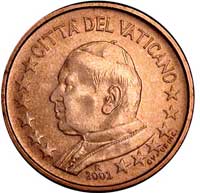 |  | 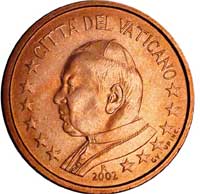 | 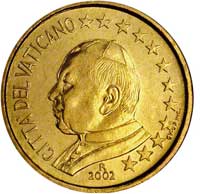 | | 1 cent | 2 cent | 5 cent | 10 cent |  |  |  | 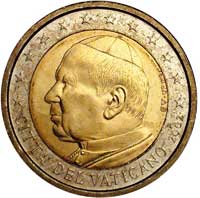 | | 20 cent | 50 cent | 1 euro | 2 euro | | In 2005 : Vacant Seat | 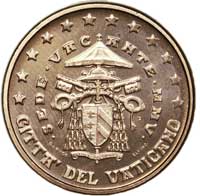 | 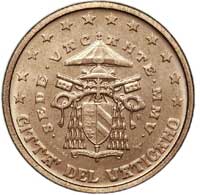 |  | 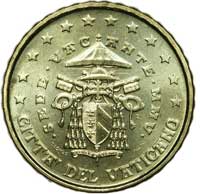 | | 1 cent | 2 cent | 5 cent | 10 cent |  | 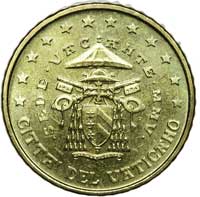 |  | 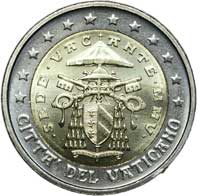 | | 20 cent | 50 cent | 1 euro | 2 euro | | From 2006 on : Benedict XVI | 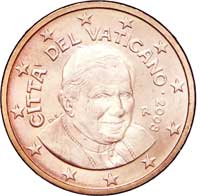 | 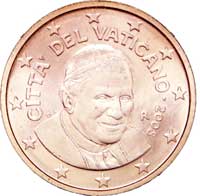 |  |  | | 1 cent | 2 cent | 5 cent | 10 cent |  | 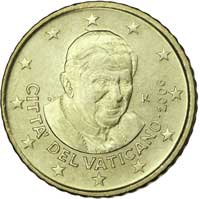 | 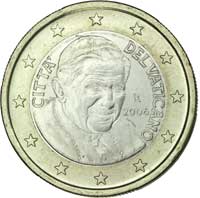 | 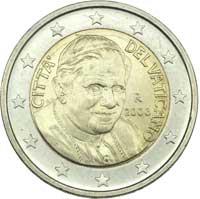 | | 20 cent | 50 cent | 1 euro | 2 euro |
The €2 commemorative coins The €2 commemorative coins
| | 2004 |  | 75th anniversary of the agreements of Lateran, at the origin of the foundation of the Vatican City State
| | 2005 |  | 20th World Youth Day in Cologne from the 15th to the 21st August 2005, the design depicts the cathedral of Cologne where took place the Eucharistic opening Celebration with the Cardinal Meisner on August 16 | | 2006 | 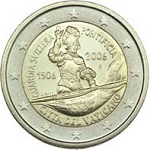 | 5th centenary the Swiss Pontifical Guard. The Swiss Pontifical Guard is the military unit of the Vatican, to ensure the protection of the pope. It was created in 1506 by the pope Julius II. Only men of Swiss nationality can integrate this unit made up of 6 officers and 110 men.
| | 2007 |  | 80th birthday of Pope Benedict XVI | | 2008 | 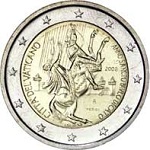 | 2000th anniversary of the birth of St. Paul | | 2009 |  | International year of astronomy |
Finally, the Vatican issues also not-circulating commemorative coins in Euro (€5, €10, €20 and €50), even if the expression “not-circulating” completely loses its meaning for the Vatican! Contact E-mail : pays@amisdeleuro.org Links - The website of the UFN (Philatelic and Numismatics Office) http://www.vaticanstate.va/FR/Services/Bureau_philatelique_et_numismatique/ - You can reach all the numismatic publications since 1929 http://www.vaticanstate.va/FR/Services/Bureau_philatelique_et_numismatique/Histoire_numismatique.htm
Top of page |

 AD€ - Les Amis de l'Euro
AD€ - Les Amis de l'Euro



























